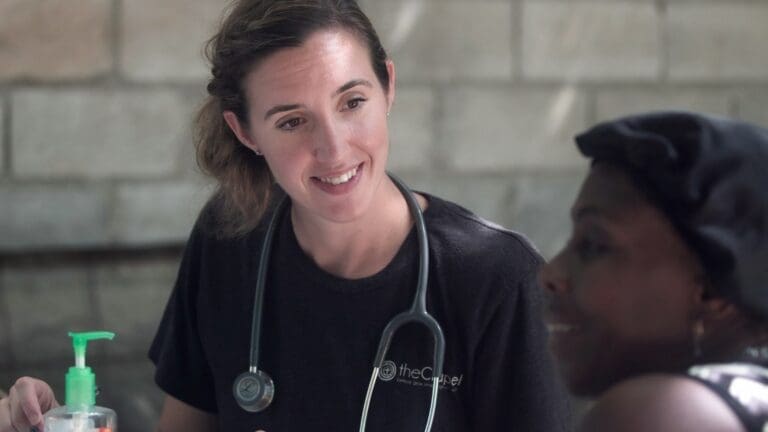Understanding Adjuvant Chemotherapy: What It Is, How It Works, and Its Role in Cancer Treatment
June 15, 2024

Adjuvant chemotherapy is a crucial aspect of cancer treatment that many patients, including those with ovarian cancer, may encounter during their journey.
Understanding what adjuvant chemotherapy entails, how it differs from neoadjuvant chemotherapy, and its potential benefits and side effects can help patients make informed decisions about their treatment plans. In this article, we’ll explore the fundamentals of adjuvant chemotherapy and its role in the fight against cancer.
What Is Adjuvant Chemotherapy?
Adjuvant chemotherapy refers to the use of chemotherapy drugs after the primary treatment, usually surgery, to destroy any remaining cancer cells and reduce the risk of cancer recurrence. The term “adjuvant” comes from the Latin word “adjuvare,” which means “to help” or “to assist.” In this context, adjuvant chemotherapy helps the primary treatment by targeting cancer cells that may have been too small to detect or remove during surgery.
The goal of adjuvant chemotherapy is twofold: first, to eliminate any microscopic cancer cells that might have spread to other parts of the body, and second, to reduce the likelihood of cancer returning in the future. By attacking these remaining cells, adjuvant chemotherapy can significantly improve a patient’s chances of long-term survival.
Healthcare providers may recommend adjuvant chemotherapy based on several factors, including:
- The type and stage of the cancer
- The likelihood of cancer recurrence
- The patient’s overall health and ability to tolerate treatment
For example, in the case of ovarian cancer treatment, adjuvant chemotherapy is often recommended for patients with stage IC or higher, as well as those with high-grade tumors. Studies have shown that even advanced low-grade serous ovarian cancer (LGSOC) has a recurrence rate as high as 70%.
While doctors usually recommend chemotherapy for high-grade tumors due to their faster growth rate, the high recurrence rate for both high-grade and advanced low-grade ovarian cancers is a significant factor in the decision to pursue adjuvant chemotherapy.
Neoadjuvant vs. Adjuvant Chemotherapy
While adjuvant chemotherapy is administered after the primary treatment, neoadjuvant chemotherapy is given before surgery. The main difference between the two lies in their timing and goals.
Neoadjuvant chemotherapy aims to shrink the tumor before surgery, making the surgical procedure less invasive and more effective. This approach can be particularly beneficial for patients with large tumors or cancers that have spread to nearby tissues. By reducing the size of the tumor, neoadjuvant chemotherapy may allow for less extensive surgery, which can lead to a faster recovery and fewer complications.
On the other hand, adjuvant chemotherapy focuses on eliminating any remaining cancer cells after surgery. This approach is often used when the tumor has been completely removed, but there is a risk of microscopic cancer cells remaining in the body.
The decision to use neoadjuvant or adjuvant chemotherapy depends on several factors, such as:
- The stage and type of cancer
- The size and location of the tumor
- The patient’s overall health and ability to tolerate surgery
In some cases, patients may receive both neoadjuvant and adjuvant chemotherapy to maximize the effectiveness of the treatment.
How Is Adjuvant Chemotherapy Administered?
Adjuvant chemotherapy can be administered in several ways, depending on the type of cancer and the specific drugs being used. The most common methods include:
- Intravenous (IV) infusion: Chemotherapy drugs are delivered directly into the bloodstream through a port, a small medical device installed beneath the skin. The port is connected to a vein, usually in the chest area, allowing for easy access during treatment sessions. A needle is inserted into the port to administer the chemotherapy drugs, which then quickly spread throughout the body and reach cancer cells in various locations. This method eliminates the need for repeated needle insertions into the veins of the arm or hand, providing a more comfortable and convenient experience for patients undergoing multiple chemotherapy cycles.
- Regional chemotherapy: In some cases, chemotherapy drugs are delivered directly to the affected area, such as the abdomen, allowing for a higher concentration of the drug in the targeted area while minimizing exposure to the rest of the body. Hyperthermic Intraperitoneal Chemotherapy (HIPEC) and Intraperitoneal (IP) chemotherapy are two common regional methods used to treat certain stages of ovarian cancer more effectively.
The duration and frequency of adjuvant chemotherapy treatments vary depending on the type of cancer, the specific drugs used, and the patient’s response to treatment.
In many cases, chemotherapy is administered in cycles, with a period of treatment followed by a rest period to allow the body to recover. For example, one cycle of chemotherapy may consist of 6 infusions, given every 3 weeks.
The total number of cycles a patient receives depends on factors such as the type and stage of cancer, as well as the individual’s response to treatment. Some patients may require multiple cycles of adjuvant chemotherapy, which can extend the total duration of treatment to several months or even up to a year or more.
In addition to chemotherapy, adjuvant treatment may also include other therapies, such as radiation therapy or targeted therapy. These treatments can be used in combination with chemotherapy to further reduce the risk of cancer recurrence and improve overall survival rates.
Does Adjuvant Chemotherapy Work?
Numerous studies have demonstrated the effectiveness of adjuvant chemotherapy in reducing the risk of cancer recurrence and improving long-term survival rates. For example, one study compared the effectiveness of two different adjuvant chemotherapy regimens (cisplatin and paclitaxel vs. carboplatin and paclitaxel) in patients with stage III ovarian cancer. The study found that both regimens significantly improved progression-free survival and overall survival compared to no adjuvant treatment.
While adjuvant chemotherapy can significantly reduce the risk of cancer recurrence, it is not without side effects. Common ovarian cancer chemotherapy side effects include:
- Fatigue
- Nausea and vomiting
- Hair loss
- Mouth sores
- Increased risk of infection
- Nerve damage (neuropathy)
- Anemia
- Diarrhea or constipation
Some of these side effects may persist long after treatment has ended. For example, nerve damage caused by chemotherapy can result in numbness, tingling, or pain in the hands and feet that may last for months or even years.
Patients need to discuss the potential benefits and risks of adjuvant chemotherapy with their healthcare team to make an informed decision about their treatment plan. While the side effects of chemotherapy can be challenging, many patients find that the potential benefits of reducing the risk of cancer recurrence outweigh the temporary discomfort and inconvenience of treatment.
Adjuvant Chemotherapy for Ovarian Cancer
Ovarian cancer is a particularly challenging disease, as it is often diagnosed at an advanced stage when the cancer has already spread beyond the ovaries. In these cases, adjuvant chemotherapy plays a crucial role in reducing the risk of recurrence and improving overall survival rates. However, the effectiveness of chemotherapy can vary depending on the subtype of ovarian cancer.
Chemotherapy for High-Grade Serous Ovarian Cancer (HGSOC)
For high-grade serous ovarian cancer (HGSOC), the most common subtype, chemotherapy is generally effective and widely used. The most common chemotherapy drugs used for treating HGSOC include:
- Carboplatin
- Paclitaxel (Taxol)
- Docetaxel (Taxotere)
- Gemcitabine (Gemzar)
- Liposomal doxorubicin (Doxil)
These drugs are often used in combination to maximize their effectiveness. For example, the combination of carboplatin and paclitaxel is a standard first-line treatment for advanced HGSOC.
Challenges with Chemotherapy for Low-Grade Serous Ovarian Cancer (LGSOC)
However, for low-grade serous ovarian cancer (LGSOC), chemotherapy is less consistent and not FDA-approved due to the slow-growing nature of these tumors. Some studies have shown that less than 20% of patients with LGSOC experience significant progress with chemotherapy.
Ovarian cancer patients need to discuss their adjuvant chemotherapy options with their healthcare team, including their gynecologic oncologist, to develop a treatment plan that takes into account their individual needs, preferences, and the specific subtype of ovarian cancer they have. During this process, patients may also wish to explore clinical trials and emerging therapies that could potentially benefit their specific case, especially for LGSOC patients who may not respond well to traditional chemotherapy regimens.
Coping with Adjuvant Chemotherapy
Undergoing adjuvant chemotherapy can be a challenging experience, both physically and emotionally. However, several strategies can help patients cope with the side effects of treatment and maintain their quality of life:
Communicate with your healthcare team: Don’t hesitate to discuss any side effects or concerns with your doctors and nurses. They can offer guidance on managing symptoms and adjusting your treatment plan if necessary.
Practice self-care: Engage in activities that promote relaxation and stress relief, such as gentle exercise, meditation, or hobbies you enjoy. Prioritize rest and sleep to help your body recover from treatment.
Maintain a healthy diet: Eating a balanced diet rich in fruits, vegetables, lean proteins, and whole grains can help support your immune system and manage side effects like nausea and fatigue.
Stay hydrated: Drinking plenty of water and other fluids can help alleviate side effects like dry mouth, constipation, and fatigue.
Seek support: Surround yourself with a strong support network of family, friends, and fellow cancer survivors. Consider joining a support group or seeking counseling to help you navigate the emotional challenges of treatment.
Remember, everyone’s experience with adjuvant chemotherapy is unique. Be patient with yourself and don’t hesitate to reach out for help when you need it.
Adjuvant chemotherapy is a vital component of cancer treatment that can significantly reduce the risk of recurrence and improve long-term survival rates. By understanding what adjuvant chemotherapy entails, how it differs from neoadjuvant chemotherapy, and its potential benefits and side effects, patients can make informed decisions about their treatment plans and work with their healthcare team to develop a personalized approach to care.
For ovarian cancer patients, adjuvant chemotherapy plays a particularly crucial role in managing this challenging disease. With the support of dedicated healthcare professionals, patients can access the latest treatments and resources to help them navigate their cancer journey with confidence and hope.
Meanwhile, non-profit ovarian cancer charity organizations like Not These Ovaries play a crucial role in supporting ovarian cancer patients by funding research and clinical trials aimed at improving treatment outcomes and quality of life. By staying informed about the latest developments in ovarian cancer treatment and seeking support from dedicated organizations, patients can feel more empowered and confident in their journey toward recovery.


